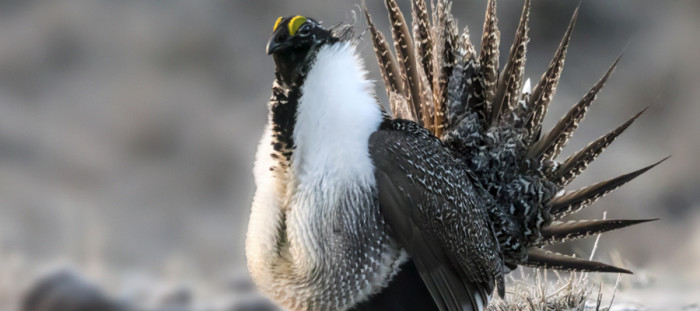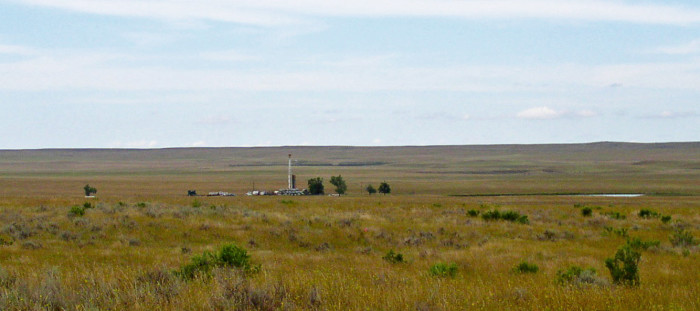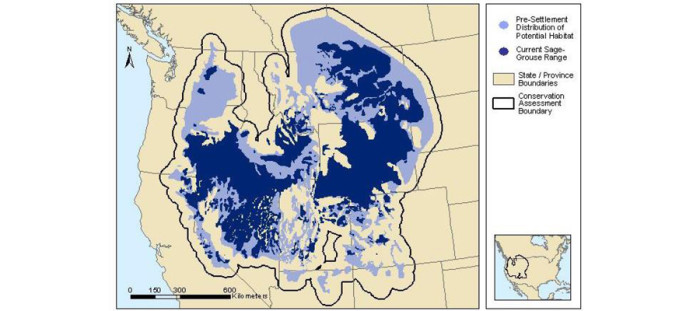We are pleased to pass along the following article from the Sage Grouse Initiative.
Rancher Ron Steineke makes water delivery and grazing improvements that benefit his cattle along with sage grouse and other wildlife.
Drought can be tough on wildlife and cattle in the northwest corner of South Dakota and on the fringe of sage grouse range. When a period of little rain hit the region in 2012, creeks and small reservoirs dried up. Today, with new funds from the Sage Grouse Initiative that help improve grazing systems, rancher Ron Steineke will at last have a reliable water source for livestock and great habitat too.
Dollars and Cents
Steineke is an avid upland bird and pheasant hunter, and he enjoys seeing quite a few white-tailed deer and antelope on the ranch. “I’m kind of a nature guy,” he says. “I don’t mind giving a little, but everything still comes down to dollars and cents.”
Today, Steineke runs about 1,000 head of cattle on a mix of 11,500 acres of private, state and Bureau of Land Management property on the rolling prairie in western South Dakota. His ranch shelters sage grouse and is important for nesting birds, especially on the western edge, close to a lek, where male grouse display and mate with hens each spring.
In a dry year, Steineke might have enough grass to get by, but without a water source near the feed, it’s difficult. “There are times when we have grass that we can use, but without water, we can’t use it,” Steineke says.
Under the Sage Grouse Initiative program, Steineke made a bold move to drill a 3,500-foot-deep water well with cost-share assistance to improve livestock and wildlife management on the large ranch. He’s also building 19 miles of pipeline to deliver water to multiple cattle pastures on the ranch.
Launched in 2010 by the Natural Resources Conservation Service, the Sage Grouse Initiative works to improve habitat on private ranchlands in 11 western states. Many of the SGI contracts with ranchers include provisions to improve the management of livestock grazing so that it’s sustainable over the long-term. The SGI motto is “Wildlife Conservation Through Sustainable Ranching.”
Water is what makes it all work
The water improvements add value to Steineke’s ranch and allow his cattle to move through a new prescribed grazing system that keeps the cows spread out throughout the year. The water developments also will benefit sage grouse, songbirds and other wildlife species that frequent the ranch.
“Water is what makes the grazing rotation work,” says Mitch Faulkner, NRCS rangeland specialist in Belle Fourche, S.D. “Prior to drilling the well, the landowner relied on surface water sources such as ponds, reservoirs and riparian areas that can go dry during a drought period.”
Steineke had an existing well prior to drilling the new one, but it wasn’t very reliable. The big expense of drilling a deep well and pipeline system—about $500,000—was tough to swallow, Steineke says, but the cost-share funds made it doable.
“It’s hard to spend that kind of money to put in the well and the pipeline, but that’s going to improve the ranch,” Steineke says. “In dry years, the water can get very stagnant and the calves won’t drink it. Now they’ll do so much better on clean water, and it’ll add to their growth.”
Grazing rotation is a good thing
The grazing plan calls for cross-fencing, to create an 11-pasture deferred grazing system, along with the new water pipelines delivering water to cattle troughs in all of the pastures.
Via the new grazing system, Steineke will reduce stocking levels from 1,000 cattle to about 750 head.
“The grazing rotation is a good thing—I’ve never done that before,” Steineke says. “I won’t be able to run as many cattle as I used to, but the grass will be better and thicker. We’ll know a lot more in three to four years, but I think there will be all kinds of extra grass out there for sage grouse and other wildlife.”
To make the deferred-rotation grazing system work, Steineke is installing approximately 3.5 miles of fencing to create the new pastures. Many of the new fences split old pastures in two. The mix of state and BLM land is managed as a whole with the private land, so the prescribed grazing system extends to management on state and BLM lands as well. To meet federal guidelines, the BLM completed an environmental assessment on the fencing and water improvements and approved them.
On the western boundary of Steineke’s property, special fence-markers will be placed on the top wire of 5,300 feet of fencing to prevent sage grouse collisions. The fence-markers show up in SGI projects across the West to make the top wire of fencing more visible. University of Idaho graduate student Bryan Stevens discovered two years ago that sage grouse collisions with barbed-wire fences were a significant source of mortality. Marking high-risk fences can reduce deaths by 83 percent.
The west side of Steineke’s property “is close to a lek,” Faulkner says. So the fence-markers will make the fencing more visible when sage grouse move in and out of the rancher’s private lands. “That’s a threat we had to address,” he said.
For more of this article and to learn more on the subject, visit http://www.sagegrouseinitiative.com/south-dakota-rancher-adds-value-operation-improves-wildlife-habitat/
About the Author: Steve Stuebner (@SteveStuebner) is a longtime journalist based in Boise, Idaho. He is also the author/producer of stories for Life on the Range.



